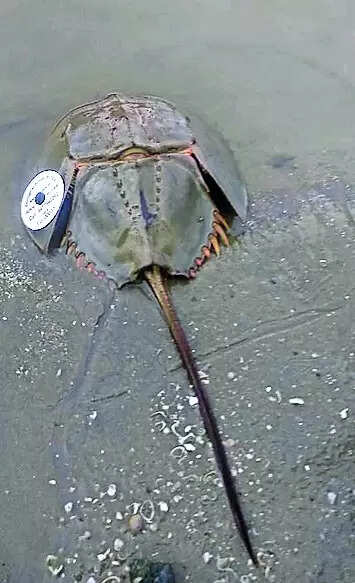Horseshoe Crabs: ZSI tags horseshoe crabs to track their movement | Bhubaneswar News

Kendrapada: In a first, 12 horseshoe crabs were tagged with semi-metallic tags to track their migratory routes. On Sunday, Zoological Survey of India (ZSI) with help from state forest department and the Centre for Research and Conservation of Indian Horseshoe crabs (CRCIHC) of Fakir Mohan University, Balasore, tagged the crabs at Khandia Muhan estuary, located near Chandipur beach.
“All the tags are marked with a serial number, mobile number and has Zoological Survey of India mentioned. Tags will help us to track the migratory routes of the marine species,” said Basudev Tripathy, scientist, ZSI at western regional centre in Pune.
B C Chaudhury, former wildlife biologist and scientific adviser of Wildlife Trust of India (WTI), said six pairs of tagged horseshoe crabs were released in the sea. “Tagging is most often conducted to obtain information on reproductive biology, movement and growth rate. The tagging will help us in studying the horseshoe crab’s migratory route and areas of foraging. Tagging data will also prove interconnection of horseshoe crab population in Odisha coast,” Chaudhury said.
India is home to two species of horseshoe crabs — Tachypleus Gigas and Carcinoscorpius Rotundicauda — both of which are found on the coasts of Odisha and West Bengal. “ZSI plans to propose to the Union ministry of environment, forest and climate change to conduct advanced research using modern techniques like satellite telemetry to gather more information about these fascinating creatures,” said Tripathy.
Horseshoe crabs have existed for over 450 million years, surviving mass extinction and environmental changes that have wiped out many other species. “These remarkable animals are not only living fossils, but also play crucial role in maintaining the ecosystem. From their contribution to coastal food webs to their importance in biomedical research, the significance of horseshoe crabs cannot be overstated. However, despite their resilience, they face increasing threats from habitat loss, climate change, and overharvesting,” Tripathy said.
“All the tags are marked with a serial number, mobile number and has Zoological Survey of India mentioned. Tags will help us to track the migratory routes of the marine species,” said Basudev Tripathy, scientist, ZSI at western regional centre in Pune.
B C Chaudhury, former wildlife biologist and scientific adviser of Wildlife Trust of India (WTI), said six pairs of tagged horseshoe crabs were released in the sea. “Tagging is most often conducted to obtain information on reproductive biology, movement and growth rate. The tagging will help us in studying the horseshoe crab’s migratory route and areas of foraging. Tagging data will also prove interconnection of horseshoe crab population in Odisha coast,” Chaudhury said.
India is home to two species of horseshoe crabs — Tachypleus Gigas and Carcinoscorpius Rotundicauda — both of which are found on the coasts of Odisha and West Bengal. “ZSI plans to propose to the Union ministry of environment, forest and climate change to conduct advanced research using modern techniques like satellite telemetry to gather more information about these fascinating creatures,” said Tripathy.
Horseshoe crabs have existed for over 450 million years, surviving mass extinction and environmental changes that have wiped out many other species. “These remarkable animals are not only living fossils, but also play crucial role in maintaining the ecosystem. From their contribution to coastal food webs to their importance in biomedical research, the significance of horseshoe crabs cannot be overstated. However, despite their resilience, they face increasing threats from habitat loss, climate change, and overharvesting,” Tripathy said.
We also published the following articles recently
ZSI inaugurates state-of-the-art Centre for Wildlife Forensics and Conservation Genomics
The Zoological Survey of India has inaugurated its Centre for Wildlife Forensics and Conservation Genomics, equipped with advanced genomic technologies. It aims to support law enforcement in tackling wildlife crime and preserving biodiversity. Dr. Mukesh Thakur was appointed as the Coordinator of the facility, which will aid in the identification and prosecution of illegal wildlife trade perpetrators.
The Zoological Survey of India has inaugurated its Centre for Wildlife Forensics and Conservation Genomics, equipped with advanced genomic technologies. It aims to support law enforcement in tackling wildlife crime and preserving biodiversity. Dr. Mukesh Thakur was appointed as the Coordinator of the facility, which will aid in the identification and prosecution of illegal wildlife trade perpetrators.
Indias three more wetlands get global tag of international importance
India’s tally of Ramsar sites has risen to 85 with the inclusion of Nanjarayan Bird Sanctuary, Kazhuveli Bird Sanctuary in Tamil Nadu, and Tawa Reservoir in Madhya Pradesh. These wetlands are crucial for maintaining the hydrological cycle and have significant biodiversity, reflecting the government’s commitment to nature conservation under Prime Minister Narendra Modi’s guidance.
India’s tally of Ramsar sites has risen to 85 with the inclusion of Nanjarayan Bird Sanctuary, Kazhuveli Bird Sanctuary in Tamil Nadu, and Tawa Reservoir in Madhya Pradesh. These wetlands are crucial for maintaining the hydrological cycle and have significant biodiversity, reflecting the government’s commitment to nature conservation under Prime Minister Narendra Modi’s guidance.
Nicobar swap: 24k hectares of Aravalis in 5 districts of Haryana get protected forest tag
Haryana designated 24,353 hectares of Aravali land across five districts as protected forest, contributing to compensatory afforestation for tropical rainforest destruction in Great Nicobar. The state’s plan, once approved, will receive Rs 3,000 crore. Most revival efforts will concentrate on soil improvement, boundary marking, and targeted plantations to prevent encroachment.
Haryana designated 24,353 hectares of Aravali land across five districts as protected forest, contributing to compensatory afforestation for tropical rainforest destruction in Great Nicobar. The state’s plan, once approved, will receive Rs 3,000 crore. Most revival efforts will concentrate on soil improvement, boundary marking, and targeted plantations to prevent encroachment.
















